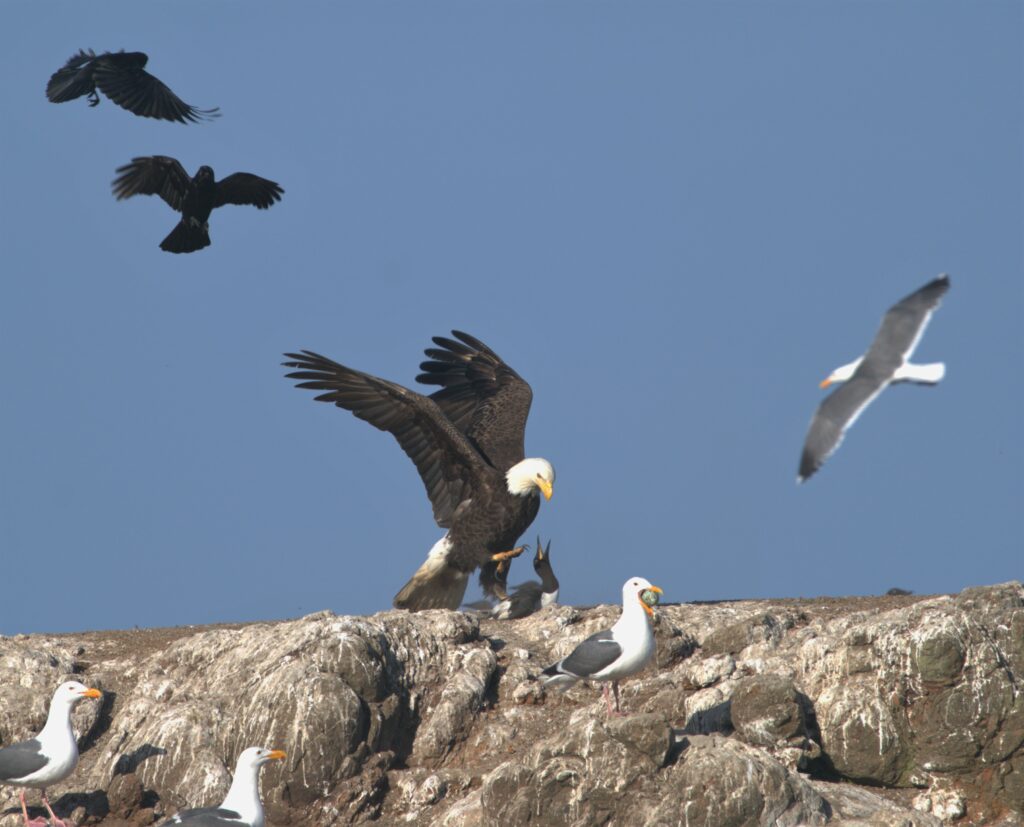By Will Kennerley, Faculty Research Assistant
It’s once again summer on the Oregon Coast and that means the seabirds are back at Yaquina Head. My name is Will Kennerley and I’m the newest faculty research assistant in the Seabird Oceanography Lab. Part of my work will include leading the monitoring fieldwork at Yaquina Head this year. I spent the previous six summers working with seabirds in the Gulf of Maine, including two seasons of fieldwork for my Master’s, which I completed here at OSU in May. I’m looking forward to applying this experience to Oregon’s large and diverse seabird populations.
Monitoring work at Yaquina Head began towards the end of May with the confirmation that Brandt’s and Pelagic Cormorants were both breeding here this year. Pelagic Cormorants failed to breed successfully in 2022, so we were anxious to see how they would perform. Much to our relief, at least 70 Pelagic Cormorant nests have been documented in Smuggler’s Cove, alone, and most have healthy clutches of four eggs.
Our very first Pelagic Cormorant chick was observed on June 23rd and we’re hopeful that there will soon be many more! As for Brandt’s Cormorants, we recorded our first chick back on June 16th and most Brandt’s nests so far have at least one hatched chick, with even more on the way! It seems that the cormorants are off to a good start this year.

In typical fashion, the situation for the Common Murres is a little less rosy. Starting in the middle of June, murre eggs appeared in a slow trickle that was easily consumed by Western Gulls during the frequent eagle disturbances. There were a couple troubling weeks in which our monitoring team would observe new nests in our monitoring plots during each visit without any of these eggs ever surviving until the following check, just two or three days later.
This situation has improved somewhat during the last week, thankfully, and eggs are being laid in greater numbers; hopefully this bump in egg-laying can overwhelm the marauding gulls and allow some eggs to survive and develop. Overall, I suspect murre productivity will be poor at Colony Rock, where I’ve seen as many six different Bald Eagles roosting at a time, but some of the smaller rocks around Yaquina Head provide better cover for the murres and have thus far avoided most of the disturbances and depredation. Although the season is advancing rapidly, there’s still some time for murres to be at least somewhat successful – I’m not ready to be pessimistic just yet! If the murres do succeed in hatching some chicks, this year’s median chick hatch date will likely be the latest ever recorded at Yaquina Head.

This year we are also systematically monitoring breeding murres and cormorants at Pirate Cove in the town of Depoe Bay. We’re employing the same protocols as at Yaquina Head, just with slightly less frequent visits. While the situation at these two colonies is broadly similar, we’ve documented fewer eagle disturbances per hour of observation at Pirate Cove than at Yaquina Head so far. Because of this, a small number of murre eggs have now been incubated for at least two weeks and I am hoping that murres at this colony will successfully produce at least a few chicks.
Also of note this year is the consistent Tufted Puffin sightings that we’ve had at Yaquina Head! As many as three individuals have been observed at once, and we’ve seen the birds circle the murre colony numerous times over the course of some mornings. One Tufted Puffin even landed on the backside of Colony Rock, where puffins once bred. While there haven’t been any signs of a nesting attempt, our hopes are high for continued puffin activity throughout this season and next.
If you’re around at Yaquina Head in the mornings, come introduce yourself! I’m typically joined by a great team comprised of Jacque (REU intern), Neci (Doris Duke scholar), and Ricardo (Environment for the Americas BLM/YHONA intern) and we’d be happy to say hello.


